By Simon L. Dolan, Anat Garti, Miriam Diez Pinol, and Pedro Cesar Martinez Moran
Creating or enhancing resilience has become a buzz phrase in recent times. The ubiquity of the term in today’s lexicon stems from a myriad of factors, including the rise of self-help culture, the glorification of struggle and adversity, and the commodification of resilience.
In an era marked by constant change and uncertainty, individuals are bombarded with messages emphasizing the importance of resilience in navigating life’s inevitable challenges. Self-help gurus and motivational speakers extol the virtues of bouncing back from setbacks, framing resilience as a prerequisite for success and fulfillment. In a society obsessed with productivity and achievement, the ability to weather storms and persevere in the face of adversity has become a coveted attribute, fueling the proliferation of resilience as a buzzword.
In a society obsessed with productivity and achievement, the ability to weather storms and persevere has become a coveted attribute.
Moreover, the romanticization of struggle and hardship in popular culture has further bolstered the status of resilience as a buzzword. From inspirational stories of individuals overcoming insurmountable odds to viral social media posts celebrating resilience, the narrative of resilience has been mythologized and glorified, perpetuating the notion that resilience is not just a desirable trait, but a heroic one.
The commodification of resilience has transformed it into a marketable commodity, with an array of products and services promising to help individuals build their resilience muscles. From resilience training programs to resilience-themed merchandise, the commercialization of resilience has capitalized on the zeitgeist of self-improvement and personal development, reinforcing its status as a buzzword that resonates with consumers seeking to enhance their capacity to cope with life’s challenges.
At the risk of adding to this discourse, the objective of this article is to offer another interesting angle of profile of resilient people based on their habits. We hope that the paper will be relevant for mental health coaches and other wellness professionals in guiding and helping their clients become more resilient.
While resilience and wellness coaching can offer some benefits in terms of promoting self-care and stress management, it is important to approach this industry with a critical eye and consider the potential drawbacks and limitations of this approach to mental health and well-being. In this article, we will concentrate on habits. In our research as well as in our coaching practices, we have identified 10 key habits of resilient people, and perhaps these can serve as a reference for the professionals in the field who will attempt to modify or change the habits of their clients / patients, rendering them more resilient and healthier psychologically.
Why Resiliency and Wellness Enhancement are so much Needed in Our Time and Age

In the face of VUCA and the global health crisis, resiliency emerges as a critical survival mechanism. It is the capacity to adapt, bounce back, and thrive in the face of adversity, setbacks, and uncertainty. Those lacking in resiliency are at risk of being overwhelmed, paralyzed, or even destroyed by the myriad of challenges that define our current reality.
The COVID-19 pandemic has exposed the vulnerabilities and fragilities of our systems and structures, laying bare the need for resilience at the individual, organizational, and societal levels. Those who are resilient can weather the storm, innovate in the face of constraints, and find new ways to thrive in a rapidly changing world.
An important lesson from the COVID-19 era underscores the importance of building and cultivating resiliency as a core competency. It is not enough to simply react to crises as they arise; rather, individuals and organizations must proactively develop the skills, mindset, and strategies needed to withstand and overcome the challenges of our time.
What are the Core Habits of Resilient People?
Research suggests that resilient individuals possess a set of core habits that enable them to navigate life’s ups and downs with grace and determination. These habits are not mere whimsical tendencies, but rather strategic behaviors that have been cultivated and honed over time through deliberate practice and introspection.
The core habits of resilient people are not innate traits, but rather learned behaviors that can be developed and strengthened over time. By cultivating adaptability, self-care, purpose, and a strong support network, individuals can enhance their resilience and better cope with life’s challenges. Resilience is not a passive quality, but an active practice that requires effort and intentionality. By embodying these core habits, individuals can build the resilience needed to thrive in a world that is constantly changing and evolving.
We have identified 10 core habits of resilient people. A summary is provided in Exhibit 1 and the further explanation that follows.
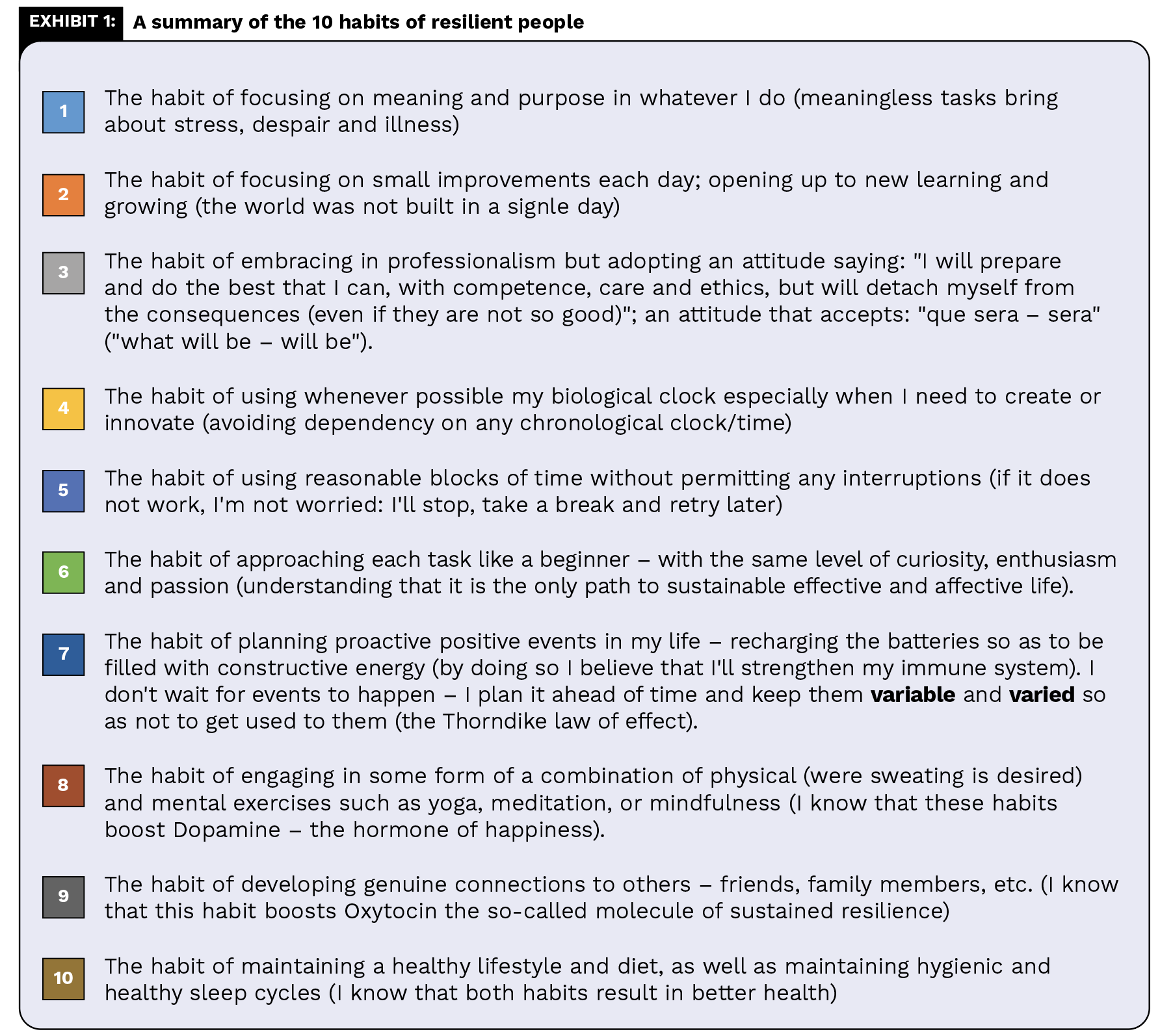
Habit 1: Resilient people find meaning and purpose in their life
Resilient individuals possess a remarkable ability to derive meaning and purpose from their life experiences. In the face of adversity and challenges, they do not succumb to despair or hopelessness but, instead, they channel their inner strength and determination to find a sense of purpose that drives them forward. This ability to find meaning during chaos is a testament to their resilience and mental fortitude.
In other words, the ability to find meaning and purpose in one’s life is a hallmark of resilience. Resilient individuals possess the inner strength and determination to derive purpose from their experiences, transforming adversity into opportunities for growth and self-discovery. By actively seeking out meaning and purpose, they can weather life’s storms with grace, emerging stronger and more resilient on the other side.
Habit 2: Resilient people are always open to learning, developing, and growing
Resilient individuals exhibit a relentless pursuit of personal growth and development, demonstrating a steadfast commitment to the concept of continuous improvement. Their unwavering dedication to enhancing their skills and knowledge sets them apart from others, as they constantly seek opportunities to expand their capabilities and achieve their full potential. This insatiable thirst for learning propels them forward, driving them to consistently seek out new challenges and experiences that will enrich their lives and enable them to overcome adversity with grace and determination. In a world where complacency and stagnation are all too common, the resilience of these individuals serves as a shining example of the power of self-motivation and the transformative impact of a growth mindset.

Habit 3: Resilient people adapt a strong cognitive attitude, saying: I´ll do the best, and … que sera, sera
Resilient individuals often exhibit a strong cognitive attitude characterized by a sense of determination and acceptance of uncertainty. This attitude is encapsulated in the phrase, “I’ll do the best that I can and … que sera, sera.” While this mantra may appear simplistic on the surface, its underlying implications reveal a complex cognitive interplay between attitudes and actions.
The notion of doing one’s best reflects a proactive stance towards challenges and adversity. It suggests a willingness to exert effort and take responsibility for one’s actions, regardless of the outcome. This proactive mindset is a key component of resilience, enabling individuals to navigate obstacles with a sense of purpose.
In this sense, the cognitive attitude of resilient individuals is a delicate balance between agency and acceptance. It reflects a nuanced understanding of the limitations of individual control, while also emphasizing the importance of acting and doing one’s best in the face of adversity. By embracing this attitude, resilient individuals can adapt to challenging circumstances with a sense of resilience and fortitude.
Habit 4: Resilient people use their biological clock rather than the chronological clock
Resilient individuals who prioritize their biological clock over the conventional chronological clock demonstrate a level of strategic thinking that sets them apart from the average populace. By aligning their activities and tasks with their natural rhythms, they can tap into a deeper well of creativity and productivity. This deliberate approach to time management allows them to optimize their energy levels and mental capacities, ultimately leading to more innovative and efficient outcomes.
By embracing their biological clock, resilient individuals can better manage stress and maintain a sense of balance in their lives.
By embracing their biological clock, resilient individuals can better manage stress and maintain a sense of balance in their lives. Rather than pushing themselves to meet arbitrary deadlines and conform to societal expectations, they can work in harmony with their natural inclinations, leading to a more sustainable and fulfilling lifestyle.
Habit 5: Resilient people make sure to maintain blocks of uninterrupted time for serious thinking and meditating prior to engaging
The ability to think critically and make informed decisions quickly is more important today than ever. Resilient individuals understand the value of setting aside dedicated blocks of time for serious thinking. They recognize that to navigate complex challenges and seize opportunities, they must engage in deep reflection and analysis.
By prioritizing uninterrupted time for contemplation and decision-making, resilient individuals demonstrate a commitment to excellence and strategic thinking. They understand that hastily made decisions can have far-reaching consequences, and they are willing to invest the necessary time and effort to ensure that their choices are well-informed and thoughtful.
Habit 6: Resilient people approach a task with passion and curiosity
Resilient individuals often exhibit a fervent dedication to their pursuits, driven by an insatiable curiosity that propels them forward. This unwavering commitment stems not just from a desire to succeed, but from a deep-seated passion for the task at hand. Their approach is not merely one of duty or obligation, but one of genuine interest and enthusiasm.
This relentless pursuit of knowledge and mastery drives them to push boundaries, explore new possibilities, and continuously seek improvement.
This fervor and curiosity serve as powerful motivators, fueling their resilience in the face of challenges and setbacks. Rather than being deterred by obstacles, they view them as opportunities for growth and learning, further igniting their passion and drive. This relentless pursuit of knowledge and mastery drives them to push boundaries, explore new possibilities, and continuously seek improvement.
In essence, the combination of passion and curiosity fuels the resilience of individuals, propelling them towards success and fulfillment. It is through this unwavering dedication to their pursuits that they can overcome adversity and emerge stronger, more capable, and more determined than ever before.
Habit 7: Resilient people program proactively positive experiences into their lives

As each person knows what makes them happy and which are the events that energize them, resilient people program these positive events into their lives. This can be a trip to the opera, taking a beer with the boys, playing golf, or having an enjoyable massage. Obviously, these events need to be carefully planned to ensure no interruptions with work or family life. Surprisingly, some of these events do not necessarily need to be very expensive.
The emphasis on “proactively” seeking out these experiences should clearly include an assurance that these actions are genuine and not simply a performance for others. The notion that small positive experiences can significantly impact one’s resilience may oversimplify the complex nature of resilience; hence, it is not solely built on fleeting moments of joy, but rather on a deep inner strength and the ability to bounce back from adversity.
Once these experiences are planned, one needs to ensure that they do not become routine. We are all aware of the “law of effect” of Thorndike that shows that any stimulus that gets repeated loses its beneficial effect. So, in spite of the fact that positive rewards tend to be repeated, they need to be spaced and varied for the effect not to diminish.1
Habit 8: Resilient people engage in physical and mental exercises
There is a wealth of literature that supports the fact that resilient people engage in either physical activity or mental activity on a regular basis. This was repeatedly tested and proved during the COVID-19 period2. In addition to resilience hormones released and strengthening of the immune system, it enhances metabolism and oxygen in the brain that facilitate better coping and better decision-making.
Nonetheless, one needs to be aware of not using physical exercise as a panacea for mental health and resilience. While dopamine release can contribute to feelings of well-being, it is not a cure-all for the complex emotional and psychological challenges that individuals may face. Overemphasizing the role of exercise in resilience-building can inadvertently minimize the importance of other factors, such as social support, therapy, and self-care practices.
Resilient individuals consistently participate in mental activities such as yoga, meditation, or mindfulness. While it is true that these practices can indeed foster mental well-being and enhance one’s ability to bounce back from adversity, it is important to challenge the notion that they are the sole or even the most effective means of cultivating resilience.
In sum, while physical activity and mental activities can undoubtedly be valuable tools in cultivating resilience, it is essential to recognize that there is no one-size-fits-all approach to building inner strength. Rather than prescribing a single path to resilience, we should encourage a more inclusive and diverse understanding of what it means to be resilient.
Habit 9: Resilient people have a genuine net of social connections
Resilience is frequently attributed to individuals who possess a robust network of social connections. The notion that social support plays a crucial role in bolstering one’s ability to bounce back from adversity is not new. However, the depth and authenticity of these connections are often overlooked in discussions about resilience.
It is not simply the quantity of social connections that matters, but the quality of those relationships that truly determines an individual’s resilience. A genuine net of social connections is one that provides unwavering support, empathy, and understanding in times of need. These connections serve as a safety net, offering comfort and reassurance during challenging times and celebrating successes during moments of triumph.
Those who possess a genuine net of social connections are not immune to hardship, but they are better equipped to navigate the turbulent waters of life with a sense of security and belonging. They know that they are not alone in their struggles and that they have a community of caring individuals who will stand by their side through thick and thin.
Habit 10: Resilient people make sure to engage in the healthy consumption of food, regular eating habits, and cycles of hygienic sleep

Resilient individuals understand the importance of maintaining a healthy lifestyle, including consuming nutritious food, adhering to regular eating habits, and practicing good sleep hygiene. These individuals recognize that their physical health directly impacts their ability to bounce back from challenges and setbacks. By prioritizing proper nutrition and consistent eating patterns, they ensure that their bodies are adequately fueled to cope with stress and adversity.
Resilient individuals understand the importance of a healthy lifestyle, regular eating habits, and good sleep hygiene.
Resilient individuals recognize that consuming nutritious food is not merely a matter of satisfying hunger, but rather a strategic investment in their overall resilience and ability to cope with life’s challenges. By prioritizing a balanced diet rich in vitamins, minerals, and antioxidants, resilient individuals ensure that their bodies are equipped to handle stress, illness, and other adversities. In essence, resilient individuals view nutrition not as a luxury or an afterthought, but as a fundamental pillar of their resilience toolkit. By making informed choices about what they eat and when they eat it, they empower themselves to face life’s inevitable ups and downs with strength, clarity, and vitality.
Resilient people also understand the pivotal role that adequate sleep plays in their overall well-being. They recognize that a lack of quality sleep can lead to decreased cognitive function, impaired decision-making, and heightened emotional reactivity, all of which can hinder their ability to effectively navigate life’s obstacles. By establishing and maintaining hygienic sleep cycles, resilient individuals safeguard their mental and emotional resilience, allowing them to face challenges with clarity and composure.
Methodologies and Tools in Measuring Resilience Habits the Basics of the Dolan Web of Resilient Habits (DWRH)
While there are numerous scales and questionnaires available to measure resilience, it is important to critically evaluate their validity and reliability, and there are few or limited scales that focus on the habits of resilient people. While there are numerous scales available to measure resilience, such as the Connor-Davidson Resilience Scale (CD-RISC)3 or the Brief Resilience Scale (BRS)4 , none of these address and measure directly the habits of resilient people. Thus, we wish to propose a short and simple measure to assess habits connected with resilience, labeled the “Dolan Web of Resilient Habits” (DWRH).5 Researchers and practitioners should be cautious about relying solely on this proposed measure and are encouraged to consider using a combination of scales, interviews, and observational methods to complement and obtain a more comprehensive understanding of the individual’s resilience habits.
Method 1: Visualizing the Web of Resilient Habits
Use the following four-point scale to assess your state of resilience based on your habits:

Place the score of each of the 10 habits on the DWRH template provided in Exhibit 2.
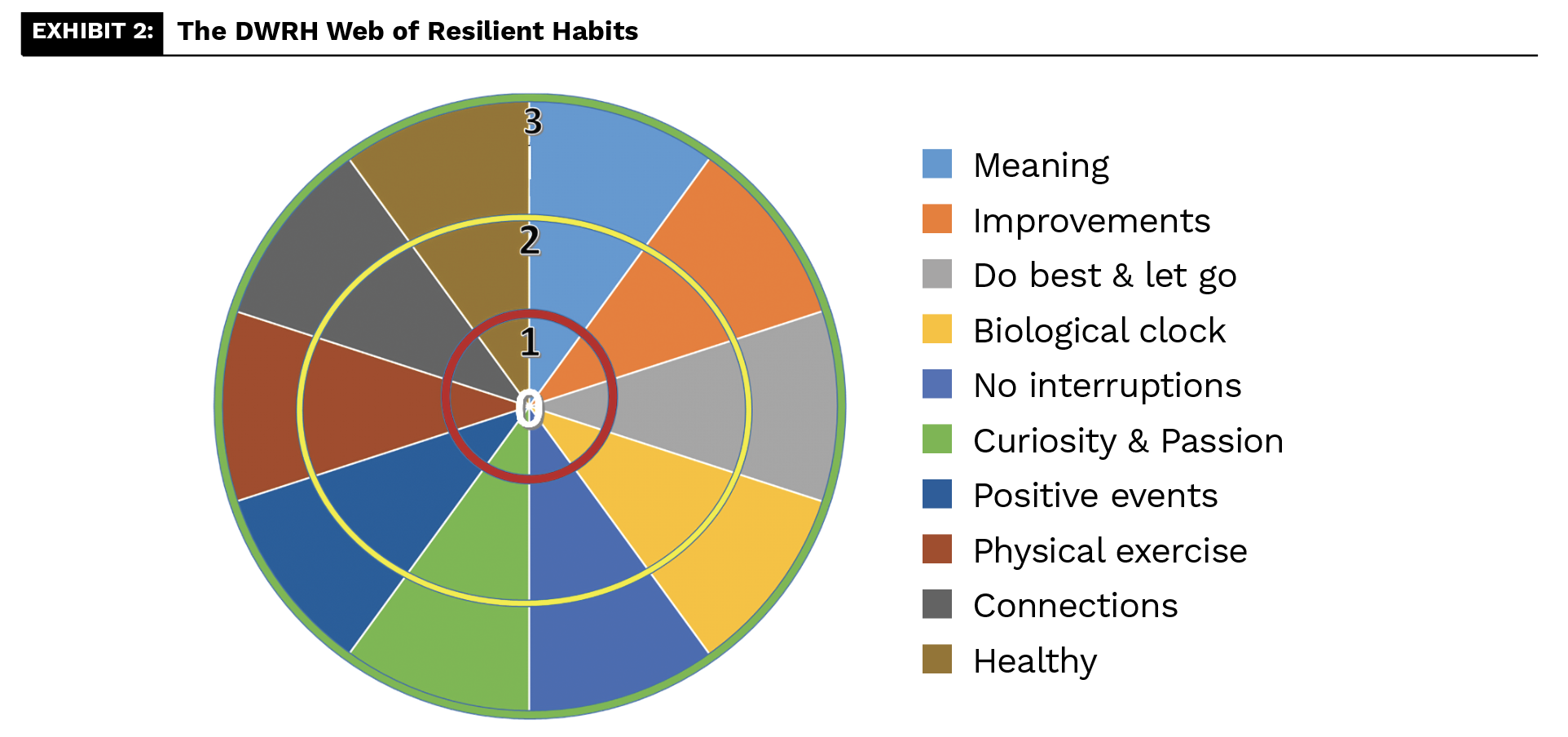
To see the web of resilience, you need to connect the dots and shade the area. All the habits that show low scores (0 or 1) need to be addressed first. This visual presentation can be very instrumental for wellness and resilience coaches.
Method 2: Calculating and interpreting the DWRH total score
In step 1, we offer a visual display of the web of habits. Here we propose another way to analyze the resilience index, by calculating the total score. To do that, sum up your choices to calculate a single composite score (which should be in the range of 0 to 30). Based on our experience, here is what the score means:6

Method 3: Personalized DWRH
Although the 10 habits are important to all, people are different in their needs and living circumstances, so there might be a variation in the influence of the habits on their resilience. For some, sleeping hours are critical; without a good sleep, they are nervous and everything stresses them; they cannot approach life’s stimuli rationally. For others, doing meaningless tasks is a source of stress. For them, the first habit is crucial.
To fit the DWRH into the aspects that characterize you, go through each of the habits we have described. Read them and ask yourself, “How important is this habit for my resilience?”7. Rate them on a scale of 1 to 3. Rate the habit as 1 if you think that it is important but you don’t believe that it will make a significant difference in your resilience. Rate 2 if you think that the habit is important for your resilience (but not essential). And rate the habit 3 if this habit is essential to your resilience and that, without practicing it, you may significantly damage your resilience.
In Table 1, place the importance of the habit and then enter the extent to which the habit exists (as in Method 1).
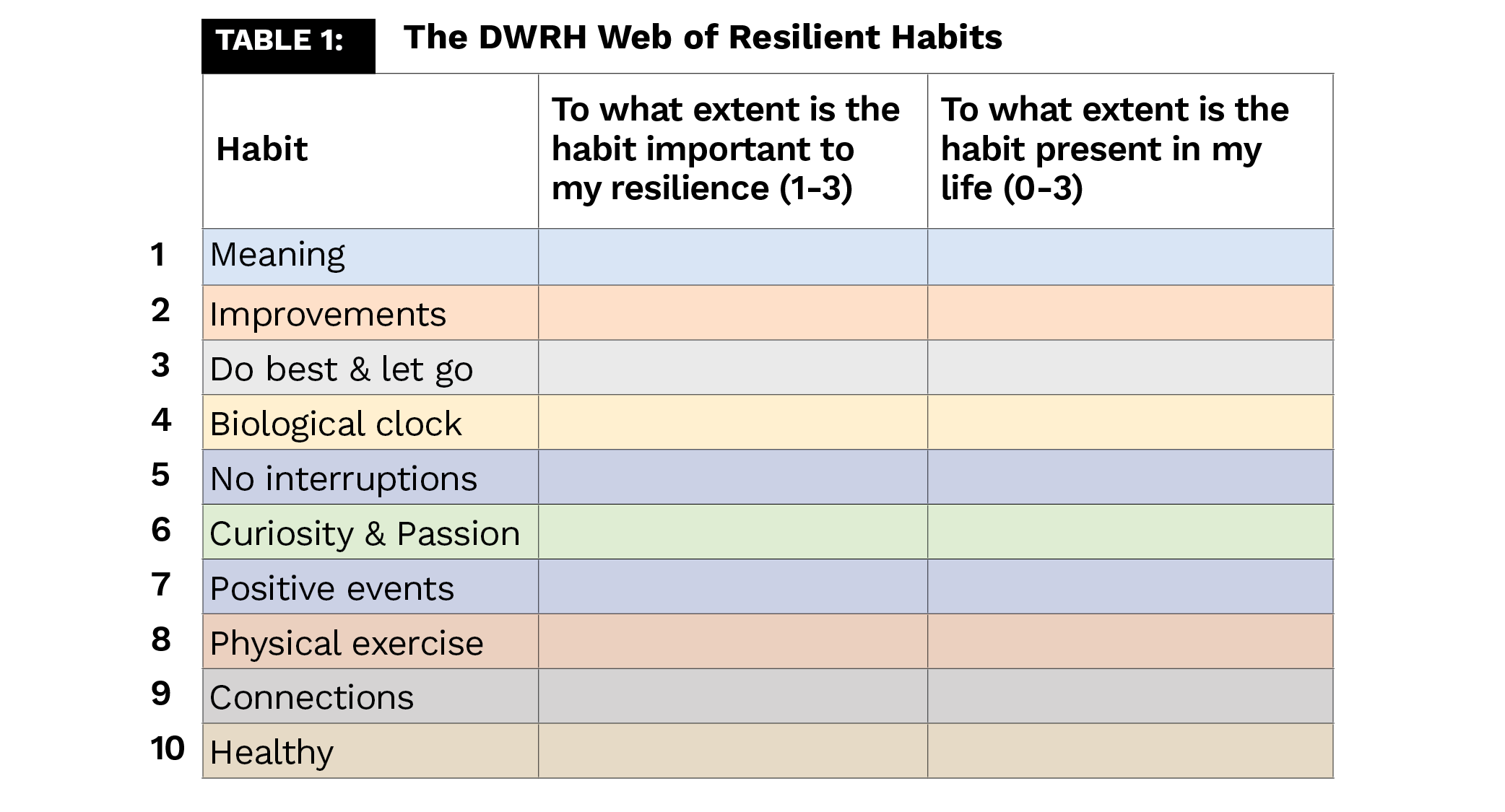
To visualize the personalized resilience, place the scores on a template (as shown in Exhibit 3). This visualization can help you evaluate the habits you should address first. The habits whose presence in your life are less than their importance, where the range column does not reach the height of the column indicating importance (the blue), are the ones that should be addressed first. Because the method can be easily used online (applying a simple Excel app). Exhibit 3 shows a screen shot of an imaginary result for a person being assessed.8

As in Method 2, and to get your personalized resilience score, calculate the importance and multiply it by each habit, so that you get a relative composite score of a habit. Then you can also sum them up to calculate your total resilience habit composite index (RCI), as shown in Table 2.
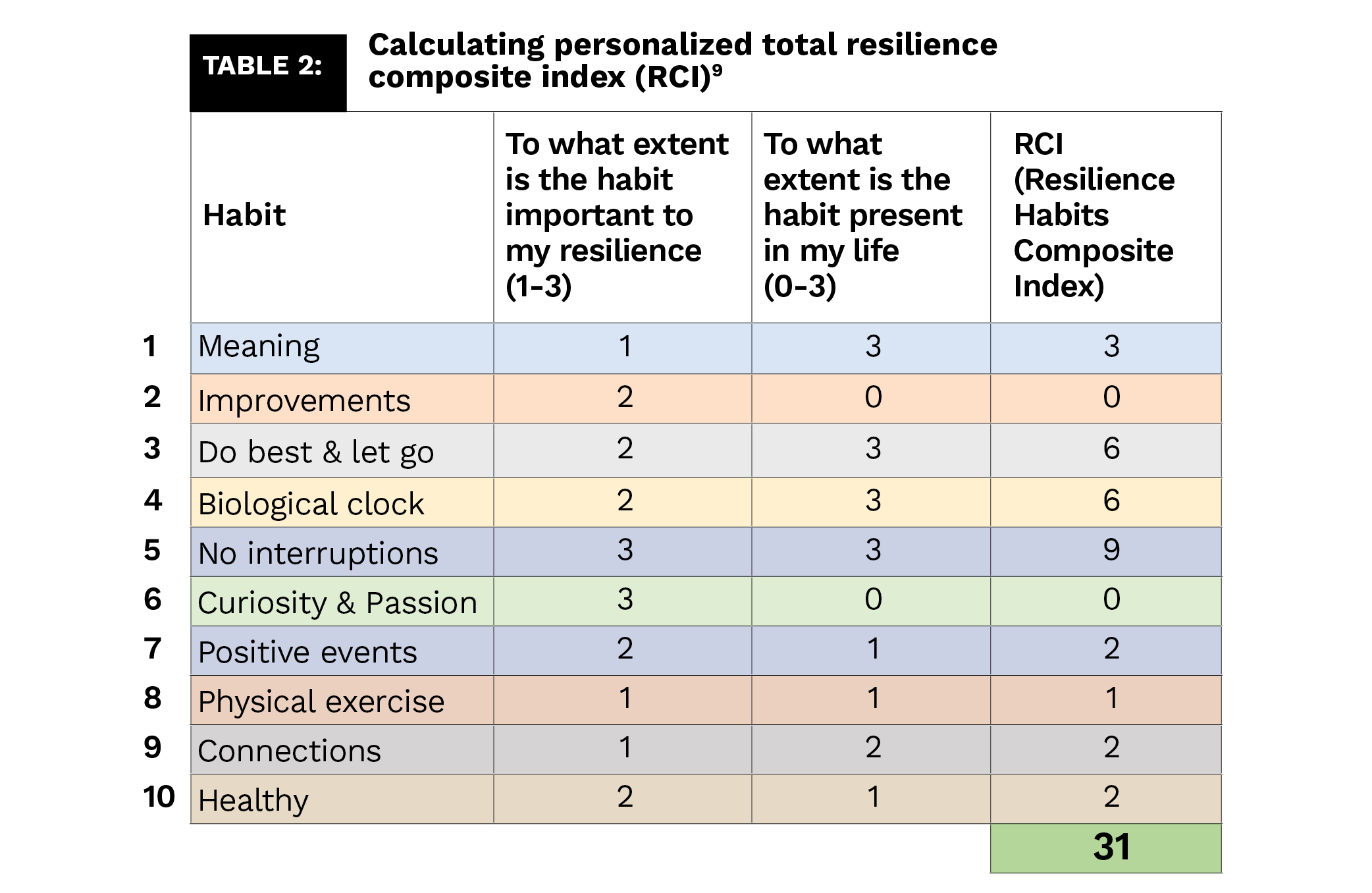
The personalized resilience habit compo-site index (RCI) could be placed in the range of 0-90 and can be interpreted as follows:

Conclusions
There is no doubt that resilience is becoming more and more important in the lives of people and especially in a work context. While resilience has been studied for many years and has been approached from many angles, the focus on habits of resilient people is innovative. In this paper, we have identified a set of 10 core habits of resilient people and offer three distinct methods to assess them and display the results, with the hope that it can be instrumental for professionals in resiliency and wellness coaching. Tools for resiliency and wellness coaching are essential components that should not be overlooked or underestimated in the field of coaching. These tools serve as the foundation for guiding individuals towards building strong mental and emotional resilience, as well as achieving overall well-being.
Tools provide a structured framework for both the coach and the client to navigate the coaching process. They act as a road map, guiding individuals through the various stages of personal growth and development. By utilizing tools, clients can gain clarity on their values, beliefs, aspirations and, most importantly, their habits in order to develop actionable steps towards achieving their desired outcomes. Tools for resiliency and wellness coaching like the one offered in this article serve as a source of empowerment. Hence, practicioners can focus on concrete strategies to enhance the resilience of their clients.


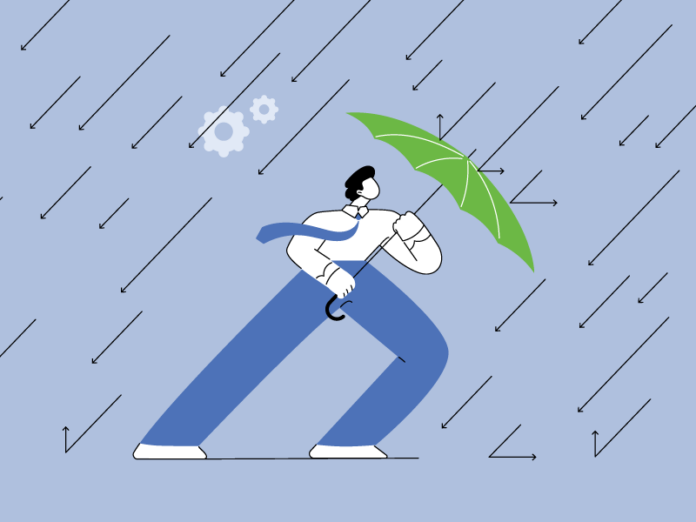
 Dr. Simon L. Dolan
Dr. Simon L. Dolan Dr. Miriam Diez Pinol
Dr. Miriam Diez Pinol  Dr. Anat Garti
Dr. Anat Garti Dr. Pedro Cesar Martínez Moran
Dr. Pedro Cesar Martínez Moran
































